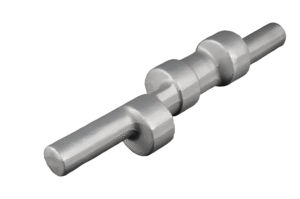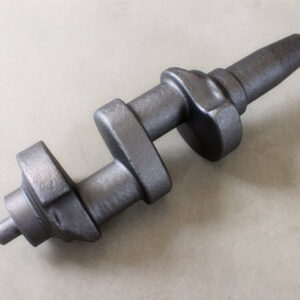Crankshaft Forgings
Crankshaft Forgings: The Ultimate Guide for Durable Engine Performance
In the world of high-performance and heavy-duty machinery, the integrity of every component is paramount. At the heart of many engines lies a critical part forged for strength and reliability: the crankshaft forging. This article explores what crankshaft forgings are, their applications, materials, the forging process, its key benefits, and how our manufacturing expertise can serve your specific needs.

What Are Crankshaft Forgings?
A crankshaft forging is a crankshaft manufactured through the industrial forging process. This involves shaping metal using localized compressive forces, typically delivered by a hammer or press. Unlike cast crankshafts, which are made by pouring molten metal into a mold, forged crankshafts are created by deforming a solid piece of metal (a billet or ingot) at high temperatures.
This process aligns the metal’s grain flow to the contours of the crankshaft, resulting in a component with superior strength, enhanced toughness, and exceptional fatigue resistance. Forged crankshafts are essential for applications that demand high reliability under extreme stress and cyclic loading.
Primary Industries Using Crankshaft Forgings
The robustness of crankshaft forgings makes them indispensable in several demanding industries:
Automotive: High-performance cars, racing vehicles, and heavy-duty trucks.
Marine: Main and auxiliary engines in ships, yachts, and other large vessels.
Aerospace: piston engines for aircraft and auxiliary power units.
Power Generation: Engines in diesel power generators and standby power systems.
Heavy Machinery & Construction: Equipment like excavators, bulldozers, and compressors.
Locomotives: Diesel engines for trains and rail transport.
Common Materials for Crankshaft Forgings
The choice of material depends on the performance requirements and application of the crankshaft. The most common materials include:
Carbon Steel: Such as 1045, 1050, and 4140 steel. 4140 chrome-moly steel is particularly popular for its high strength and good fatigue resistance.
Alloy Steel: Grades like 4340 and EN19 are used for highly stressed crankshafts in demanding environments, offering excellent strength and toughness.
Stainless Steel: Used in specific applications where corrosion resistance is a priority, such as in marine environments.

The Crankshaft Forging Process
The creation of a forged crankshaft is a multi-step, precision-driven operation:
Billet Heating: A steel billet of the required grade is heated to a precise high temperature in a furnace to make it malleable.
Forging: The heated billet is placed into a forging die and shaped under immense pressure using a powerful hammer or press. This step forms the basic shape of the crankshaft, including the main journals, crankpins, and counterweights.
Trimming & Punching: Excess material (flash) is trimmed away, and holes are punched if necessary.
Heat Treatment: The crankshaft is subjected to controlled heating and cooling processes (such as quenching and tempering) to enhance its mechanical properties like hardness, strength, and toughness.
Machining: The forged crankshaft is precision-machined to achieve final dimensions, surface finish, and tolerances. This includes grinding the journals and pins to a mirror-like finish.
Inspection & Testing: The finished crankshaft undergoes rigorous quality checks, including dimensional verification, ultrasonic testing for internal defects, and magnetic particle inspection for surface flaws.
Key Benefits of Forged Crankshafts
Choosing a forged crankshaft offers significant advantages over cast or machined-from-bar alternatives:
Superior Strength & Durability: The forging process refines the metal’s grain structure, creating a part that can withstand high stress and impact loads without failing.
Excellent Fatigue Resistance: Forged crankshafts have a much longer service life under cyclic loading conditions, preventing cracks and fractures.
Enhanced Reliability: The consistent and dense internal structure minimizes the risk of hidden voids or inclusions, ensuring dependable performance in critical applications.
Economic Efficiency for High Volumes: While the initial tooling cost can be high, forging becomes very cost-effective for mass production due to its high material utilization and production speed.
Key Benefits of Forged Crankshafts
Choosing a forged crankshaft offers significant advantages over cast or machined-from-bar alternatives:
Superior Strength & Durability: The forging process refines the metal’s grain structure, creating a part that can withstand high stress and impact loads without failing.
Excellent Fatigue Resistance: Forged crankshafts have a much longer service life under cyclic loading conditions, preventing cracks and fractures.
Enhanced Reliability: The consistent and dense internal structure minimizes the risk of hidden voids or inclusions, ensuring dependable performance in critical applications.
Economic Efficiency for High Volumes: While the initial tooling cost can be high, forging becomes very cost-effective for mass production due to its high material utilization and production speed.
Custom Crankshaft Forgings Based on Your Drawings
We understand that every engine and application has unique requirements. That’s why we offer comprehensive custom crankshaft forging services. Our engineering team can manufacture crankshafts precisely according to your technical drawings and specifications. We work with you to ensure the final product meets your exact performance, material, and dimensional needs.
Mass Production Capability
In addition to custom orders, we are equipped for high-volume mass production. Our advanced forging facilities and streamlined processes allow us to produce large quantities of high-quality crankshaft forgings consistently and efficiently, ensuring reliable supply for your production lines.
Contact us today to discuss your crankshaft forging requirements and experience the strength and reliability that only a forged component can provide.
